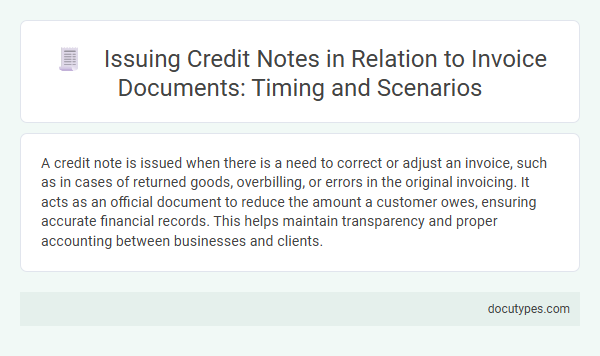A credit note is issued when there is a need to correct or adjust an invoice, such as in cases of returned goods, overbilling, or errors in the original invoicing. It acts as an official document to reduce the amount a customer owes, ensuring accurate financial records. This helps maintain transparency and proper accounting between businesses and clients.
Understanding Credit Notes in Invoice Management
A credit note is issued when an invoice requires adjustment due to returned goods, pricing errors, or overbilling. This document serves as a formal record to reduce the amount owed by the customer.
Understanding credit notes helps maintain accurate financial records and improves invoice management efficiency. You should issue a credit note promptly to ensure clear communication between your business and clients.
Key Scenarios Requiring Credit Notes
A credit note is issued to adjust or correct invoice discrepancies. It serves as an official document to amend billing errors and reflect accurate transaction details.
- Returned Goods - A credit note is issued when customers return products due to defects or incorrect shipments.
- Overbilling Errors - It corrects invoices that contain higher charges than agreed upon, ensuring accurate payment.
- Discounts and Rebates - Used to apply post-invoice discounts or promotional rebates not included in the original invoice.
Timing: When to Issue a Credit Note
A credit note is issued after an invoice has been sent when there is a need to correct billing errors, such as overcharges or returned goods. It must be issued promptly once the discrepancy is identified to ensure accurate financial records and maintain customer trust. Timely issuance of credit notes also facilitates seamless accounting reconciliation and tax reporting compliance.
Legal Requirements for Issuing Credit Notes
A credit note is issued when there is a need to correct or cancel part of an issued invoice due to returns, discounts, or billing errors. Legal requirements dictate issuing credit notes to maintain accurate financial records and comply with tax regulations.
Your business must issue a credit note promptly after identifying the discrepancy in the original invoice. Tax authorities often require credit notes to reference the original invoice number and state the reason for adjustment. Failure to comply with these regulations can result in penalties and complications during audits.
Steps in Issuing a Credit Note Against an Invoice
| Step | Description |
|---|---|
| 1. Identify the Need for a Credit Note | Recognize discrepancies such as returned goods, overcharging, or canceled orders that require adjustment to the original invoice. |
| 2. Verify Original Invoice Details | Review the invoice number, date, customer information, and amounts to ensure the credit note accurately references the original transaction. |
| 3. Prepare the Credit Note Document | Create a credit note containing essential details: credit note number, date of issue, references to the original invoice, reason for issuance, and adjusted amounts. |
| 4. Obtain Necessary Approvals | Secure authorization from relevant departments or personnel responsible for financial adjustments before issuing the credit note. |
| 5. Dispatch the Credit Note to the Customer | Send the credit note using agreed communication channels, ensuring Your customer receives timely notification of the adjustment. |
| 6. Update Accounting Records | Record the credit note in the accounting system to adjust outstanding balances and maintain accurate financial statements. |
| 7. Monitor and Reconcile Accounts | Track the application of the credit note against payments or future invoices to ensure proper reconciliation. |
Common Mistakes in Credit Note Issuance
A credit note is issued when an invoice requires adjustment due to errors or returned goods. Proper timing and accuracy are essential to maintain financial records integrity.
- Issuing a Credit Note Before Invoice Confirmation - This mistake leads to confusion and discrepancies in accounting records.
- Incorrect Reference to Original Invoice - Failing to link the credit note correctly causes tracking and reconciliation issues.
- Delaying Credit Note Issuance - Late issuance affects cash flow management and customer trust.
Impact of Credit Notes on Accounting and Taxation
When is a credit note issued in relation to invoice documents? A credit note is issued when there is a need to correct or adjust a previously issued invoice due to errors, returns, or discounts. This document serves as evidence to reduce the amount owed by the customer, directly impacting accounting records and tax calculations.
How do credit notes affect accounting and taxation processes? Credit notes decrease accounts receivable balances and adjust revenue figures, ensuring accurate financial reporting. For taxation, they reduce the taxable sales amount, which can lead to adjustments in VAT or sales tax liabilities reported to tax authorities.
Best Practices for Documenting Credit Notes
Credit notes are issued to correct or adjust the amounts on previously issued invoices. Proper documentation of credit notes ensures accurate financial records and compliance with accounting standards.
- Reference the Original Invoice - Always include the original invoice number to maintain clear linkage between documents.
- Detail the Reason for the Credit - Clearly state why the credit note is issued, such as returned goods or pricing errors.
- Use Sequential Numbering - Assign unique, sequential numbers to credit notes for easy tracking and auditing.
Maintaining thorough and transparent credit note documentation improves financial accuracy and supports effective dispute resolution.
Integrating Credit Note Processes with ERP Systems
A credit note is issued when an invoice requires correction due to errors, returns, or discounts to adjust the original billing. Integrating credit note processes with ERP systems ensures accurate financial records and seamless updating of accounts receivable. ERP integration automates validation, approval workflows, and real-time synchronization of credit notes with existing invoice data, enhancing operational efficiency.
When Is a Credit Note Issued in Relation to Invoice Documents? Infographic

